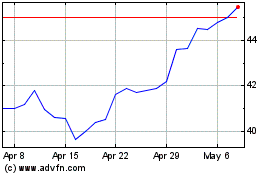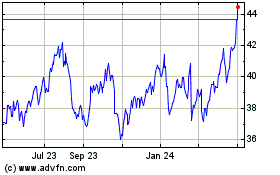Fed Stress Tests Show U.S. Banks Can Withstand Covid-19 Pandemic -- 2nd Update
December 18 2020 - 6:32PM
Dow Jones News
By Andrew Ackerman and David Benoit
The Federal Reserve said Friday that the largest U.S. banks
remain strong enough to survive the coronavirus crisis but warned
that a prolonged economic downturn could saddle them with hundreds
of billions of dollars in losses on soured loans.
The Fed also said it would allow the banks to restart share
buybacks but that it would, at least in the first quarter, restrict
the amount. It said it would continue to restrict dividend
payouts.
Under two hypothetical scenarios, in which unemployment remains
high and the economy doesn't bounce back for several quarters, the
33 largest U.S. banks could be hit with as much as $600 billion in
loan losses, the Fed said in the latest iteration of its stress
test. That would erode the capital buffers meant to keep them on
sound financial footing, the central bank said.
Designed to gauge the health of the nation's banks, the stress
tests were expanded this year to study the effect of the downturn
brought on by the coronavirus pandemic.
Earlier this year, the Fed placed restrictions on the biggest
banks' dividend payouts and share buybacks, a move to preserve
capital in an unsettled economy. At that time, the Fed stopped all
buybacks and said dividends couldn't exceed a bank's recent
profits. The Fed in September extended the restrictions through the
end of this year.
On Friday, the Fed said the banks could restart making
repurchases in the first quarter, but still can't return to
shareholders more than they have been making in profit over the
past year. The aggregate dividends and repurchases can't exceed the
average quarterly profit from the four most recent quarters.
Randal Quarles, the Fed's vice chairman of supervision, said the
banking system "has been a source of strength during the past
year."
"Today's stress test results confirm that large banks could
continue to lend to households and businesses even during a sharply
adverse future turn in the economy," Mr. Quarles said in a
statement.
In an initial round of stress tests, the Fed said in June that
U.S. banks were strong enough to withstand the crisis but
restricted dividend payouts and buybacks to make sure they stayed
that way. Those tests, which the banks submitted in early April,
reflected hypothetical downturns that were crafted before the
onslaught of the coronavirus pandemic. The Fed subsequently added
three extreme scenarios to the initial round of stress tests, but
only released aggregate, and not individual, results of those
tests.
The results released Friday reflect a second round of tests
after the Fed required banks to resubmit updated capital plans to
reflect the coronavirus crisis. Unlike in the earlier set of tests,
the Fed released the results for each bank.
Under both hypothetical scenarios, each firm met its risk-based
capital requirements. All but one firm, HSBC Holdings PLC, remained
above the leverage requirements, the central bank said.
The Fed said both scenarios for the fall tests weren't forecasts
and are significantly more severe than most current baseline
projections for the path of the U.S. economy.
The banks have been preparing for potential loan losses, putting
aside billions of dollars in the first half of the year. The big
banks have added more than $100 billion in loan-loss reserves, the
Fed said, a move that fueled an increase in their capital cushions.
A key metric known as the common-equity Tier 1 ratio, which is a
measure of high-quality capital as a share of risk-weighted assets,
increased from 12% in the first quarter to 12.7% at the end of
September for the largest lenders.
But the banks slowed reserve building in the third quarter when
executives said they felt prepared for steep losses. Analysts began
anticipating that they would be freed by regulators to start
returning capital.
After the results were released, JPMorgan Chase & Co.
announced it would repurchase $30 billion in stock and would start
in the first quarter. Its shares rose 5.1% in after-hours trading
Friday. Other banks climbed as well, with Citigroup Inc. up
5.4%.
The decision regarding capital distributions generated a dissent
from Lael Brainard, an Obama appointee on the Fed board, who said
the restrictions are too loose.
"Today's action nearly doubles the amount of capital permitted
to be paid out relative to last quarter," she said in a statement.
"Prudence would call for more modest payouts to preserve lending to
households and borrowers during an exceptionally challenging
winter."
Write to Andrew Ackerman at andrew.ackerman@wsj.com and David
Benoit at david.benoit@wsj.com
(END) Dow Jones Newswires
December 18, 2020 18:17 ET (23:17 GMT)
Copyright (c) 2020 Dow Jones & Company, Inc.
HSBC (NYSE:HSBC)
Historical Stock Chart
From Mar 2024 to Apr 2024

HSBC (NYSE:HSBC)
Historical Stock Chart
From Apr 2023 to Apr 2024
